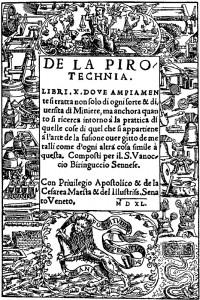Book Review – “The Pirotechnia of Vannoccio Biringuccio” – translated by C. S. Smith and M. T. Gnudi
This is a translation of the first known printed book on metallurgy. Written a century after the European printing tradition began, it is surprisingly technical, considering that it was published in 1540. It covers all aspects of metalwork, from mine to workshop, including a great many processes from the medieval period. Gunpowder and strong acids were not the latest inventions when Biringuccio was writing, but here they are described as large-scale operations, and in this way, the treatise is a key document in the history of metallurgy, chemistry and science.
As you would expect from Smith, the translation contains detailed notes, both on the language used, and technical information about the processes described. There are ambiguities in the text – Biringuccio writes in a conversational style, eager to befriend the reader, share his knowledge, and entertain. No translation can be completely accurate, but his sense of humour is clear, and there are some noteworthy quotes. Discussing the alleged virtues of gold, he says, “Many learned men say that this power has been conceded to it by the benign influence of the sun and that for this reason it gives so much pleasure and benefit with its great powers – particularly to those who have great sacks and chests full of it.” (p.27). On the search for eternal life, and the mystic alchemists, he says “But in spite of alll this, the fathers and inventors of the art who exalted it with such high praise are all dead and have not enjoyed even on period of youth, to say nothing of two or three; and as far as I know they are not yet raised from the dead as they promised.” (p.39)
Despite these comic turns, the treatise is far from light-hearted. This is dangerous, expensive foundry work, and Biriguccio stresses that there is no luck or magic in the foundry, only good practice. He lays down instructions which should be followed, but insists that the reader should experiment until they find the best solution for their situation.
In this way, the text is a useful workshop companion for the founder or the experimental archaeologist or, but less so for the craft practitioner. The sections on the different types of smithing are comprehensive, but very short. Those interested in Renaissance jewellery manufacturing would be better to read Cellini’s treatises, which have very detailed accounts of decorative and sculptural methods.
Indeed, the onl y artistic aspects (in the modern sense) are the woodcuts which illustrate the text. Though they are not as technically descriptive (or as numerous) as Agricola’s offering in De Re Metallica, they are very useful – care is taken to show the location of the work (eg. outdoors, or in a building), and the materials that everything is made from, even showing grain of the wooden beams. Like the text itself, the images are not abstract observations, instead showing a lively, pragmatic understanding of the techniques they describe.
y artistic aspects (in the modern sense) are the woodcuts which illustrate the text. Though they are not as technically descriptive (or as numerous) as Agricola’s offering in De Re Metallica, they are very useful – care is taken to show the location of the work (eg. outdoors, or in a building), and the materials that everything is made from, even showing grain of the wooden beams. Like the text itself, the images are not abstract observations, instead showing a lively, pragmatic understanding of the techniques they describe.
Although he was not a scientist as we would understand it now, and certainly not part of an intellectual elite, Biringuccio formalised his knowledge and experience, and shared it. It is somewhat unfortunate that Agricola, who wrote after him, and borrowed from Pirotechnia, was quoted until the Industrial Revolution by other writers, whereas Biringuccio was largely overlooked until the 20th century (despite some of the information coming from him!).
Copies of this book are around £10 – a small investment for the treasure trove of information that it contains.
Comments on this entry are closed.